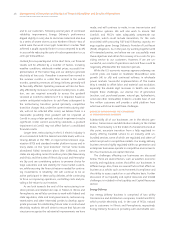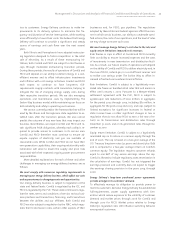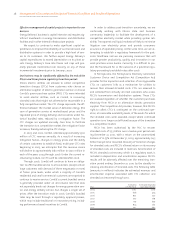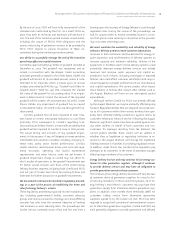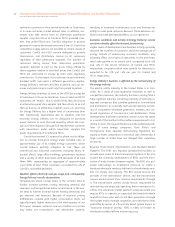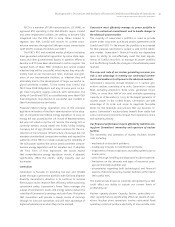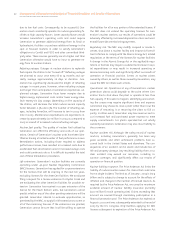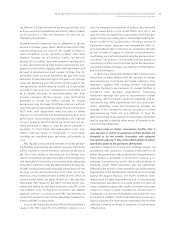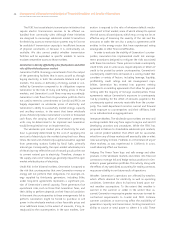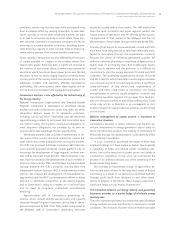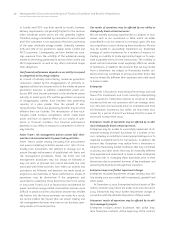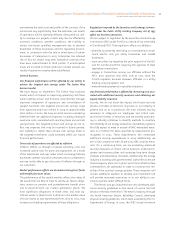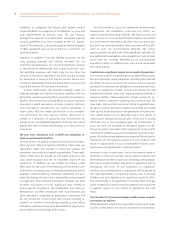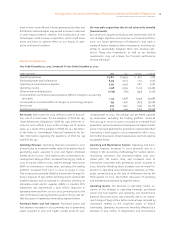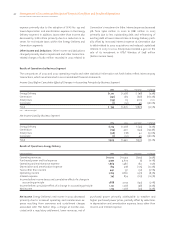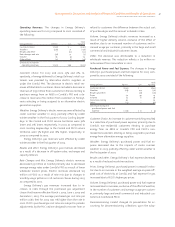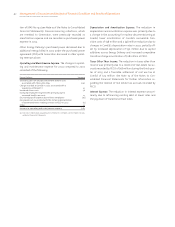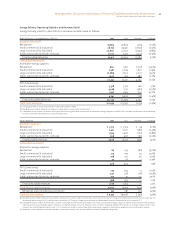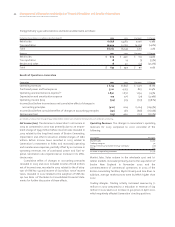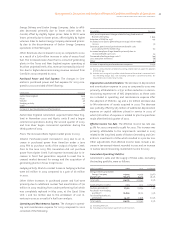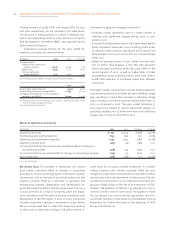ComEd 2003 Annual Report Download - page 38
Download and view the complete annual report
Please find page 38 of the 2003 ComEd annual report below. You can navigate through the pages in the report by either clicking on the pages listed below, or by using the keyword search tool below to find specific information within the annual report.36 Management’s Discussion and Analysis of Financial Condition and Results of Operations
EXELON CORPORATION AND SUBSIDIARY COMPANIES
to ComEd and PECO vary from month to month; however,
delivery requirements are generally highest in the summer
when wholesale power prices are also generally highest.
Therefore, energy committed by Generation to serve ComEd
and PECO customers is not exposed to the price uncertainty
of the open wholesale energy market. Generally, between
60% and 70% of our generation supply serves ComEd and
PECO customers. Consequently, we have limited our earn-
ings exposure from the volatility of the wholesale energy
market to the energy generated in excess of the ComEd and
PECO requirements, as well as any other contracted longer
term obligations.
Our financial performance depends on our ability to respond
to competition in the energy industry.
As a result of industry restructuring, numerous generation
companies created by the disaggregation of vertically in-
tegrated utilities have become active in the wholesale power
generation business. In addition, independent power pro-
ducers (IPP) have become prevalent in the wholesale power
industry. In recent years, IPPs and the generation companies
of disaggregated utilities have installed new generating
capacity at a pace greater than the growth of elec-
tricity demand. These new generating facilities may be more
efficient than our facilities. The introduction of new tech-
nologies could increase competition, which could lower
prices and have an adverse effect on our results of oper-
ations or financial condition. Our financial performance
depends on our ability to respond to competition in the en-
ergy industry.
Power Team’s risk management policies cannot fully elimi-
nate the risk associated with its power trading activities.
Power Team’s power trading (including fuel procurement
and power marketing) activities expose us to risks of com-
modity price movements. We attempt to manage our ex-
posure through enforcement of established risk limits and
risk management procedures. These risk limits and risk
management procedures may not always be followed or
may not work as planned and cannot eliminate the risks
associated with these activities. Even when our policies and
procedures are followed, and decisions are made based on
projections and estimates of future performance, results of
operations may be diminished if the judgments and
assumptions underlying those decisions prove to be wrong
or inaccurate. Factors, such as future prices and demand for
power and other energy-related commodities, become more
difficult to predict and the calculations become less reliable
the further into the future estimates are made. As a result,
we cannot predict the impact that our power trading and
risk management decisions may have on our business, oper-
ating results or financial position.
Our results of operations may be affected by our ability to
strategically divest certain businesses.
We are actively pursuing opportunities to dispose of busi-
nesses, such as our investment in Sithe, which are either
unprofitable or do not advance our strategic goals. We may
incur significant costs in divesting these businesses. We also
may be unable to successfully implement our divestiture
strategy of certain businesses for a number of reasons, in-
cluding an inability to locate appropriate buyers or to nego-
tiate acceptable terms for the transactions. The inability to
divest certain businesses could negatively affect our results
of operations. In addition, the amounts that we may realize
from a divestiture are subject to fluctuating market con-
ditions that may contribute to pricing and other terms that
may be materially different than expected and could result
in losses on sales.
Enterprises
Enterprises is focused on maximizing the earnings and cash
flows of its investments and is not currently contemplating
any acquisitions. Enterprises expects to continue to divest
businesses that are not consistent with our strategic direc-
tion. This does not necessarily mean an immediate exit from
all Enterprises’ businesses, but rather, we may retain busi-
nesses for a period of time if we believe that this course of
action will increase their value.
Enterprises’ results of operations may be affected by its abil-
ity to strategically divest certain businesses.
Enterprises may be unable to successfully implement its di-
vestiture strategy of certain businesses for a number of rea-
sons, including an inability to locate appropriate buyers or to
negotiate acceptable terms for transactions. In addition, the
amount that Enterprises may realize from a divestiture is
subject to fluctuating market conditions that may contribute
to pricing and other terms that may be materially different
than expected and could result in losses on sales. Enterprises
also faces risks in managing these businesses prior to their
divestitures due to potential turnover of key employees and
operating the businesses through their transition.
Enterprises may incur further impairment charges.
Enterprises recorded impairment charges totaling $140 mil-
lion during 2003 associated with investments, goodwill and
other assets.
At December 31, 2003, Enterprises had total assets of $831
million, of which $214 million are under contract to be sold in
2004. Enterprises may incur further impairment charges in
connection with the ultimate disposition of these assets.
Enterprises’ results of operations may be affected by its abil-
ity to manage its projects.
Enterprises includes certain businesses that utilize long-
term fixed-price contracts. At the beginning of the contract,


